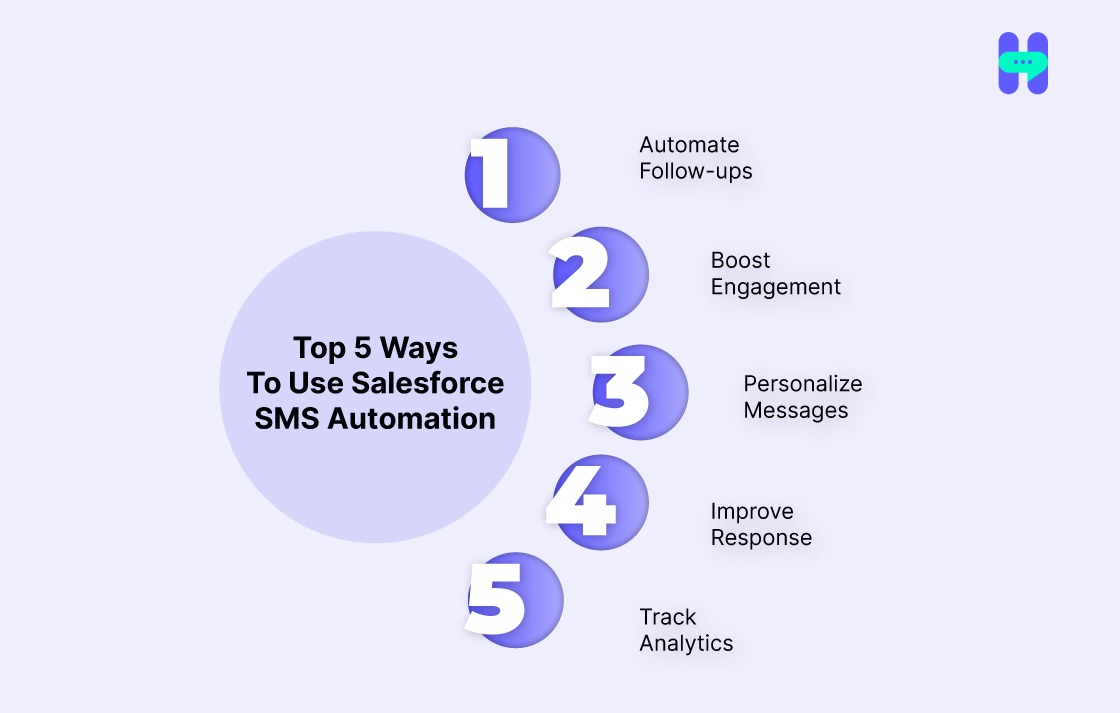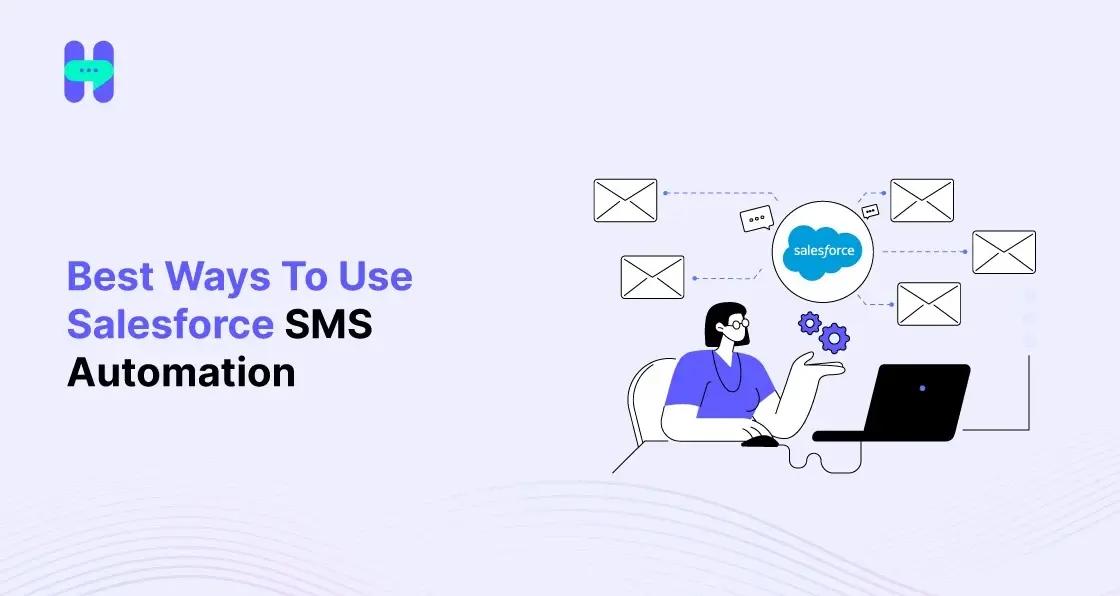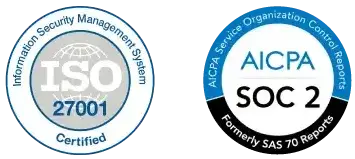Quick Summary
Enhance your Salesforce workflow with SMS Automation. Learn how it accelerates follow-ups and improves customer engagement with seamless integration.
Timely follow-ups can make or break a deal. They are the secret to stronger customer engagement and higher conversions.
Here’s the kicker SMS messages boast open rates of around 98%, far beyond email. That means if you’re not using SMS, you’re leaving attention on the table. But let’s be real manual follow-ups are messy.
That’s where SMS Automation steps in. Paired with Salesforce SMS and seamless Salesforce SMS integration, it automatically sends the right message, to the right person, at the right time no reminders, no bottlenecks.
In this blog, you will see how Salesforce workflow automation with SMS can ease your workload, speed up responses, and how tools can make your work more easier.
Let's get started!
How Salesforce Automation Can Ease Your Work?
Here are five game-changing ways that automation inside Salesforce can lighten the load and boost your effectiveness.
- Automated Workflows: Rather than a rep remembering to send an SMS or wondering which lead needs follow-up, you set up triggers in Salesforce: e.g., a lead hasn’t responded in 24 hours → auto-send a text. That’s Salesforce workflow automation in action.
- Time Savings: Every minute spent manually checking statuses, drafting next-message drafts, tracking down tasks adds up. When you automate your follow-ups using SMS, you save time. That time becomes available for refining strategy, building relationship, or focusing on high-value tasks.
- Enhanced Efficiency: Automation means once you’ve set the logic, messages go out uniformly and reliably. No one falls through the cracks, no follow-up falls short because someone forgot. Your process becomes efficient, predictable, and repeatable. This also boost customer retention.
- Improved Accuracy: Manual work introduces human error: wrong message sent, delay in sending, mismatch in context. Automation reduces that risk. By connecting SMS data with your Salesforce records, you ensure personalization and relevancy critical for salesforce customer engagement.
- Streamlined Communication: With automation and SMS built into your Salesforce system, your messaging flows through CRM, not a separate tool. This means no switching platforms, no lost context. You build a clean pipeline of communication, traced and tracked.
Top 5 Ways To Use Salesforce SMS Automation

Boost follow-up with these five Salesforce SMS Automation tactics.
1. Automate Follow-ups
Trigger SMS when tasks are overdue, leads unresponsive, or key milestones hit. For example: After a demo, if no reply in 48 hours, send: "Hey [Name], thanks for the demo yesterday. Any questions? I’m here." This workflow ensures leads stay engaged and improves response rates by promoting timely follow-ups.
Key Points:
- Trigger Messages: Use workflows to send SMS if a lead hasn’t replied, a task is overdue, or a milestone reached.
- Real-Time Response: Don’t let leads sit idle. Send timely texts after demos or resource downloads to keep momentum.
- Consistent Communication: Automation ensures all leads get follow-ups—no missed steps or human delays.
2. Boost Engagement
Pair SMS with email and calls. With high open rates, SMS grabs attention fast. If no email open in 24 hours, send an SMS. If no SMS response in 48 hours, follow up with a call. This flow maximizes engagement and restarts conversations if emails are ignored.
Key Points:
- Multi-Channel Strategy: Blend Salesforce SMS with email and calls. If emails go unread, SMS ensures your message reaches your audience immediately, increasing the likelihood of engagement.
- Timely Nudges: Schedule SMS reminders before meetings or follow-ups to help prospects remember appointments and stay engaged.
- Human Messaging: Write simply and conversationally. Friendly texts outperform formal ones.
3. Personalize Messages
Generic messages fail. Use Salesforce data name, company, activity, product interest to personalize. Personalized SMS builds trust and increases response rates by making outreach relevant and engaging. For example: "Hi [Name], saw you viewed our X-module yesterday. Want a 10-min call?" This will leads to improve customer relation.
Key Points:
- Dynamic Personalization: Use real-time Salesforce data to create targeted messages.
- Behavior Triggers: Send custom messages based on user actions like "cart abandoned," "demo attended," or "contract pending."
- Segmented Campaigns: Segment Salesforce SMS audiences by interest, location, or funnel stage to deliver more relevant content and increase engagement.
4. Improve Response
Texts are read fast, yielding quick responses. Combine SMS advertising with follow-ups via email, automated SMS, and calls. SMS prompts instant replies or next steps, helping you move deals faster and keep your audience engaged.
Key Points:
- Instant Communication: SMS is read within minutes, helping your sales team close loops faster.
- Smart Cadence: Start with email, then automated SMS, then a call. It feels personal yet runs automatically.
- Encourage Replies: End texts with a question or CTA for easy response.
5. Track Analytics
Automation isn’t "set and forget." Use Salesforce dashboards to track SMS messages collection, delivery, response, conversion, and ROI. Monitor performance in real time and adjust workflows as needed to keep your campaigns optimized and results-driven.
Key Points:
- Built-In Dashboards: Track SMS delivery, responses, and conversions in Salesforce CRM.
- Performance Optimization: Spot which messages and timings engage best, then adjust automation.
- ROI Visibility: Connect SMS results to revenue to prove automated follow-up impact.
HelloSend: One Stop Solution For Salesforce SMS Integration

If you’re already using Salesforce, you know it’s the nerve center of your sales and customer engagement efforts. But what if you could bring SMS and WhatsApp directly into that ecosystem? No more switching tabs, juggling tools, or missing messages.
That’s exactly what HelloSend the CRM messaging tool does. It turns Salesforce into a complete messaging powerhouse. SMS Automation, WhatsApp, and Salesforce workflows all connect into one seamless engine.
Whether it’s a sales follow-up, service reminder, or marketing campaign, HelloSend ensures your messages reach customers instantly, right where they are most responsive.
Key Features Of HelloSend For Salesforce

- Native Salesforce Integration: HelloSend integrates directly into Salesforce. There’s no complicated setup and no third-party connectors. You can send and receive Salesforce SMS and WhatsApp messages without leaving your CRM. Every message, response, and update sync automatically with your records.
- Automated Workflows: Use Salesforce workflow automation to trigger SMS or WhatsApp messages based on specific actions. These can include new leads, overdue tasks, or closed deals. Set it once and HelloSend handles the rest.
- Two-Way Messaging: Communicate in real time. With HelloSend, your sales and support teams can have two-way SMS and WhatsApp conversations directly from Salesforce. No more lost context. Every interaction is logged and visible in one place.
- Personalized Campaigns: Combine HelloSend automation with Salesforce data to create messages tailored by customer name, interests, or milestones. Launch campaigns that automatically adapt messages for each recipient to increase conversions.
- Multi-User Collaboration: Assign conversations to specific team members. View full communication histories. Ensure your customers always get a fast, personal response.
- Unified Analytics: Monitor message delivery, response rates, and conversions directly in Salesforce dashboards. View real-time data on your SMS Automation's impact on customer engagement, retention, and return on investment.
To know more about this, click here.
Other Integrations
HelloSend doesn’t stop at Salesforce. It connects easily with other major business tools, including following:-
Beyond CRM integrations, HelloSend also supports WhatsApp Business API. This gives you another powerful channel for customer engagement. You can automate reminders, send order updates, and run multi-channel campaigns. Blend Salesforce SMS and WhatsApp messages, all from a single dashboard.

Best Practices for Effective SMS Follow-ups
To get the most out of your SMS automation, following best practices is essential. Here are four you must adhere to.
Timing
Send your SMS when your recipient is likely available and receptive. Because SMS gets read fast you want to avoid odd hours or text that feels intrusive. Also align it logically: send shortly after a trigger rather than days later.
Conciseness
Keep messages short, clear, and direct. SMS is not the place for long paragraphs. A quick message that asks a question or prompts action ("Any questions about your demo?" or "Ready to schedule next step?") works far better.
Clear Call-to-Action
Every message should point to the next step. Without clarity, the follow-up loses impact. For instance: “Reply ‘YES’ and I’ll schedule a call,” or “Click this link to pick a time,” or “Text STOP to opt out” (for compliance). This is the best customer engagement strategies.
Compliance
Respect data privacy, opt-in requirements, messaging frequency. Even though SMS cut-through is strong, misuse can lead to opt-outs or brand damage. For example, users will unsubscribe if they receive too many irrelevant messages.
Wrap Up!
Adapting Salesforce SMS Automation can significantly enhance your follow-up strategies. You’ll speed up your response time, increase engagement, and give leads a better brand experience.
By integrating tools like HelloSend for seamless Salesforce SMS integration, you’re not just adding another channel you’re creating a smooth, optimized communication pipeline that drives salesforce workflow automation, enhances salesforce customer engagement, and ultimately boosts conversions.
Don’t let manual follow-ups hinder your business growth. Start automating your SMS follow-ups with HelloSend and see the difference it makes.

Frequently Asked Questions (FAQs)
Q1: What Is SMS Marketing?
A: SMS marketing is a strategy that uses text messages to connect with customers directly on their phones. Businesses use it to share promotions, updates, reminders, and personalized offers. It’s fast, cost-effective, and highly engaging, making it one of the most effective ways to boost sales and build stronger customer relationships in real-time.
Q2: What is Salesforce SMS automation?
A: Salesforce SMS automation refers to automating the sending of SMS messages via your Salesforce CRM. It allows you to trigger texts based on workflows, record changes or customer actions ensuring timely and consistent follow-up without manual intervention.
Q3: How can SMS automation improve follow-up efficiency?
A: Because SMS messages are read almost instantly (some studies show within minutes) and with high open rates, automating follow-ups via SMS means faster response times, fewer missed opportunities, and a smoother engagement journey with your leads and customers.
Q4: How does HelloSend enhance Salesforce SMS integration?
A: HelloSend is built to integrate directly into Salesforce, allowing you to automate SMS from within your CRM no separate texting platform needed. It ties into your workflows, enables personalization from Salesforce data, and provides analytics so you can track the impact of your Salesforce SMS Marketing campaigns.
Q5: What are the best SMS plugins that integrate with Salesforce?
Some of the best SMS plugins that integrate with Salesforce include Twilio, 360 SMS App, and SMS Magic. These tools let you send, automate, and track text messages directly from your Salesforce dashboard, improving communication and lead follow-ups effortlessly.
Q6: Are there affordable Salesforce SMS automation solutions?
Yes! Affordable Salesforce SMS automation solutions like HelloSemd offer cost-effective plans for sending bulk texts, setting up automated workflows, and tracking engagement—all within your Salesforce CRM






